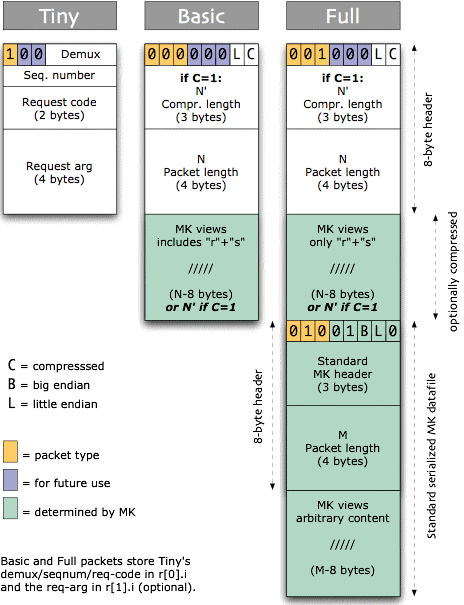top pages
Soapbox
Blog Company
About
| Remote procedure calls Metakit storages (both file-based and in-memory) can easily be serialized and de-serialized using the load/save calls provided in each language binding. This capability has been used in a number of projects to send MK data "over the wire", i.e. across sockets. A small extension to this concept is to also send a bit of extra information, turning such serialized streams into Remote Procedure Calls, effectively. MK-RPC is a formalization of this idea, with some conventions added to greatly enhance its inter-operability across machines, platforms, and languages. design The API of MK-RPC deals with sending requests and receiving replies, both using the same protocol. The amount of meta information sent alongside a MK storage is constrained to:
And of course an optional MK storage. This maintains total extensibility, even when the above format is too restrictive, because arbitrarily large and complex data can always be added to the MK storage object itself. MK-RPC is designed to be extremely efficient and add very little overhead:
The design takes advantage of the fact that MK storages are 100% self-descriptive, that they take care of byte-order issues, and that the header of a serialized stream contains the size of the entire object. With some extra logic, all types of requests are distinguishable in the receiver by simply examining the first 8 incoming bytes. programming interface The design of the calling API is language specific. Basically, the call to send a request is: mkrpcsend <iochan> <reqcode> <intlist> <strlist> <storage> Where the last three arguments are optional. This is not the whole story: there are also a few options, to specify compression and to indicate whether a storage may be modified in place to include some extra data (an optimization trade-off). The reply will contain these same items, requests and replies share the same logic. MK-RPC has been designed to later support asynchronous use, and multiplexing of multiple request/reply streams over a single connection. protocol The following figure describes the protocol of bytes going over the wire: | metakit index • Overview • Download • Quotes • Links | ||||
 | ||||||